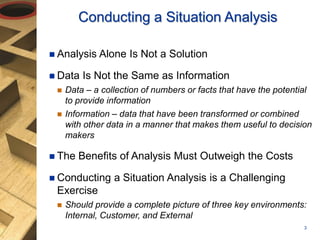The document discusses developing competitive advantage and strategic focus through situation analysis and SWOT analysis. It covers collecting and analyzing marketing information, including conducting an internal, customer, and external environment analysis. A SWOT analysis framework is then presented for organizing environmental data. Key elements of a SWOT analysis include identifying strengths, weaknesses, opportunities, and threats within the internal and external environments. Conducting a thorough situation analysis and SWOT is important for informing marketing strategy and leveraging competitive advantages.















































